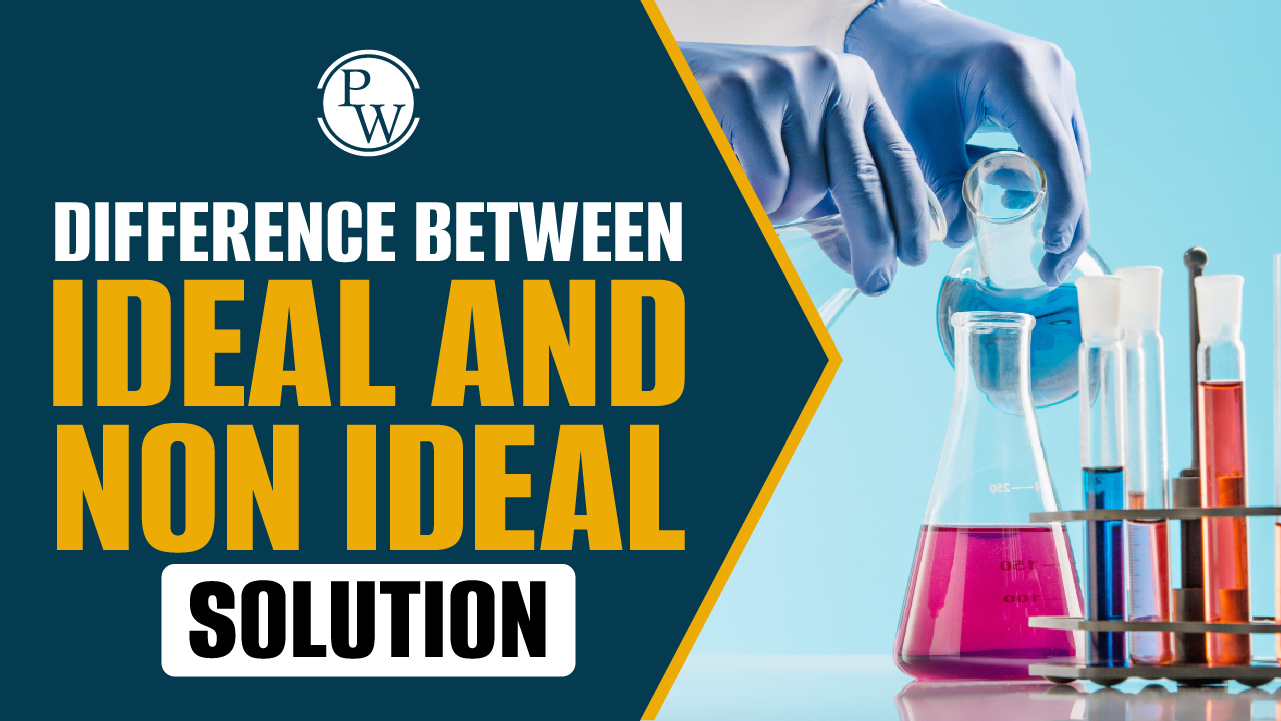Difference Between Ideal and Non-Ideal Solutions

The chapter on Ideal and Non-Ideal Solutions is crucial for understanding the behavior of different solutions under varying conditions. Many students struggle with differentiating between these two types because the concepts involve thermodynamic properties like enthalpy, volume, and vapor pressure.
Understanding the difference between ideal and non-ideal solutions is essential in chemistry, especially for students preparing for NEET exams 2025. Solutions are classified based on their adherence to Raoult’s Law, which describes the relationship between the vapor pressure of a solution and its components. We will explore what are ideal and non-ideal solutions, their characteristics, and key differences.
What Are Ideal and Non-Ideal Solutions?
Ideal Solutions
An ideal solution is a theoretical concept where the intermolecular interactions between solute and solvent are identical to those in pure components. These solutions obey Raoult’s Law at all concentrations and temperatures, with no changes in enthalpy or volume upon mixing.
Characteristics of Ideal Solutions:
-
Obey Raoult’s Law.
-
ΔHmix (Enthalpy of Mixing) = 0, meaning no heat is absorbed or released.
-
ΔVmix (Volume of Mixing) = 0, meaning the total volume is equal to the sum of individual volumes.
-
Intermolecular forces between different components remain unchanged.
-
No deviations from Raoult’s Law.
Examples of Ideal Solutions:
-
Benzene and Toluene
-
n-Hexane and n-Heptane
-
Chlorobenzene and Bromobenzene
Non-Ideal Solutions
A non-ideal solution does not strictly follow Raoult’s Law due to variations in intermolecular interactions between solute and solvent molecules. These solutions may show positive or negative deviations, affecting properties like boiling point, vapor pressure, and enthalpy of mixing.
Characteristics of Non-Ideal Solutions:
-
Do not obey Raoult’s Law at all concentrations.
-
ΔHmix ≠ 0 (heat is either absorbed or released upon mixing).
-
ΔVmix ≠ 0 (total volume differs from the sum of components).
-
Unequal intermolecular interactions between solute and solvent.
-
May exhibit positive or negative deviations from Raoult’s Law.
-
Some non-ideal solutions form azeotropes (constant boiling mixtures).
Examples of Non-Ideal Solutions:
-
Ethanol and Acetone (Positive Deviation)
-
Chloroform and Acetone (Negative Deviation)
-
Phenol and Aniline (Negative Deviation)
Check Out: NEET Previous Year Papers Books
Differences Between Ideal and Non-Ideal Solutions
|
Property |
Ideal Solution |
Non-Ideal Solution |
|
Raoult’s Law |
Obeys at all concentrations |
Deviates positively or negatively |
|
Enthalpy of Mixing (ΔHmix) |
Zero (No heat exchange) |
Non-zero (Heat absorbed or released) |
|
Volume of Mixing (ΔVmix) |
Zero (Volume remains same) |
Non-zero (Volume changes) |
|
Intermolecular Forces |
Similar forces in all components |
Different forces between solute and solvent |
|
Deviation from Raoult’s Law |
No deviation |
Positive: Higher vapor pressure, Negative: Lower vapor pressure |
|
Formation of Azeotropes |
No azeotrope formation |
Can form azeotropes |
|
Nature of Components |
Similar in size, polarity |
Different in size, shape, or polarity |
Also Check, NEET Test series
Use the Right Books to Clear Your Doubts
Right books will help you understand this better and mock tests will help you to write in confident.
|
Book Name |
Link |
PDFs |
|
Chemistry Med Easy |
||
|
Sprint NEET Crash Course Class 11 & 12 |
||
|
NTA NEET New Pattern Rankers Test Series 2025 |
||
|
45 Days NEET Most Wanted Chemistry |
Why Understanding Ideal and Non-Ideal Solutions is Important
Questions on the difference between ideal and non-ideal solution frequently appear in NEET Chemistry. Recognizing examples, deviations, and thermodynamic properties (ΔHmix, ΔVmix) is essential. For instance, azeotropes’ inability to be purified via distillation is a common application-based question.
The difference between ideal and non-ideal solutions lies in their adherence to Raoult’s Law, intermolecular interactions, and thermodynamic properties. Ideal solutions maintain uniform interactions and follow predictable behavior, while non-ideal solutions exhibit variations that impact their physical and chemical properties. Understanding these distinctions is essential for mastering solution chemistry concepts.
Read More: NEET Handwritten Revision Notes PDF with Solutions
Ideal and Non-ideal Solutions FAQs
1. What is the main difference between ideal and non-ideal solutions?
The main difference between ideal and non-ideal solution lies in their adherence to Raoult’s Law, enthalpy changes, and volume changes during mixing.
2.What causes non-ideal behavior in solutions?
Non-ideal behavior arises from differences in molecular size, shape, polarity, and intermolecular forces between components.
3. What are examples of ideal solutions?
Examples include benzene-toluene and n-hexane-n-heptane, where components have similar properties.
4. Can non-ideal solutions form azeotropes?
UNder UNYes, non-ideal solutions can form azeotropes, which are constant boiling mixtures that cannot be separated by distillation.












